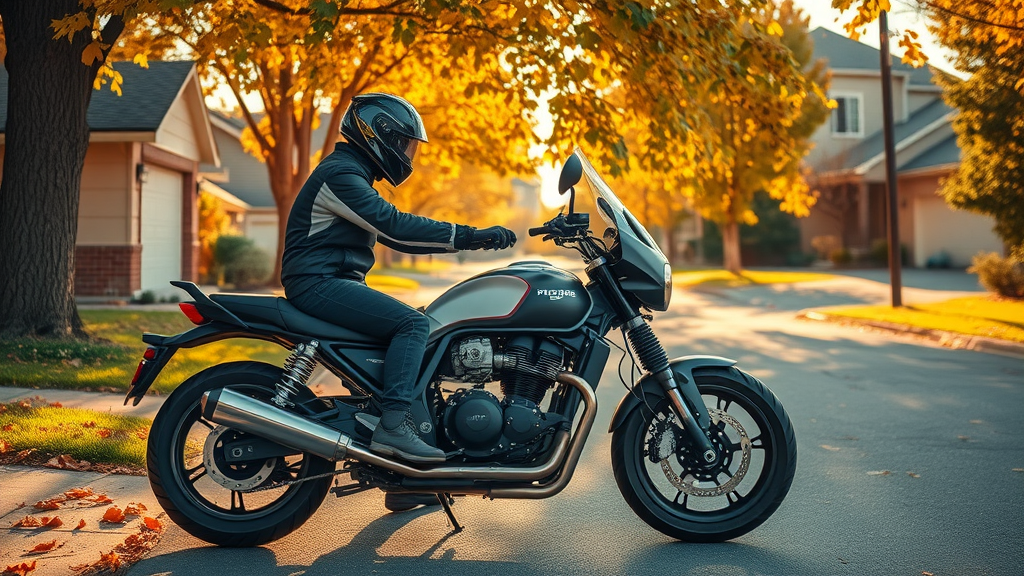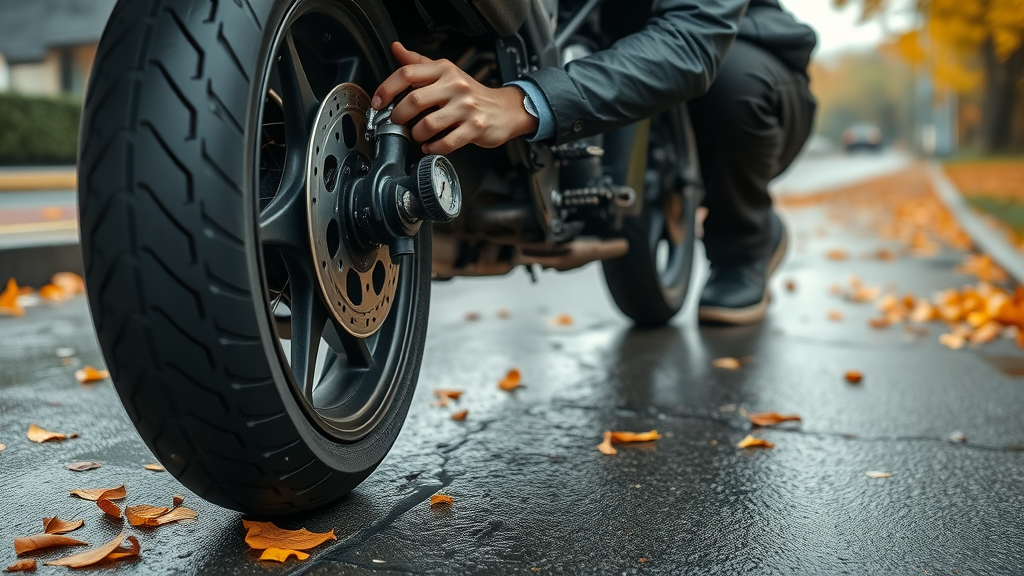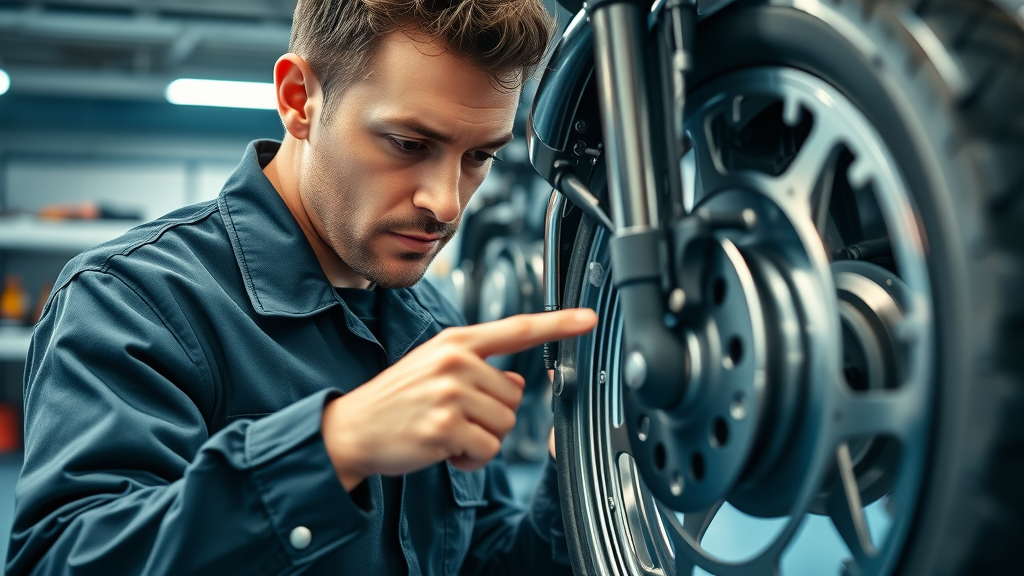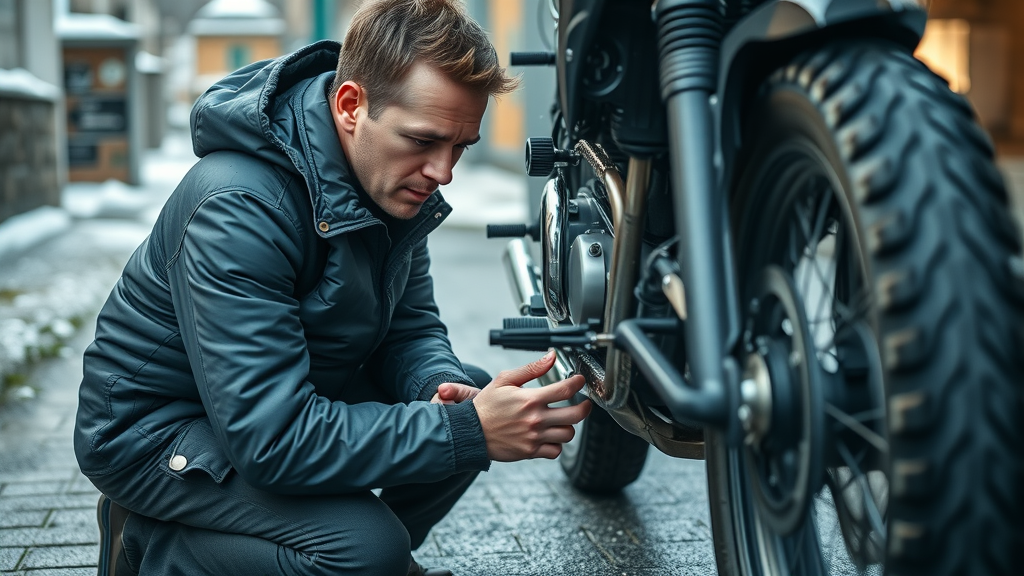Startling Statistic: According to recent studies, over 30% of motorcycle accidents in autumn are linked to preventable mechanical failures—making fall motorcycle maintenance more critical than ever.
- In this article, you'll discover everything you need to know to keep your motorcycle in top shape this fall, prevent breakdowns, and ensure a safe riding experience all season long.
- Key takeaways and maintenance tips for safe fall riding are included throughout.

Staying Safe This Season: Why Fall Motorcycle Maintenance Matters
Fall brings scenic rides, vibrant foliage, and cooler temperatures, attracting riders eager to make the most of the open road before winter arrives. However, the transition in weather also introduces unique challenges—from falling leaves that obscure road hazards to sudden temperature drops affecting tire pressure , fluid levels , and battery performance. Fall motorcycle maintenance is all about proactively addressing these seasonal changes to reduce the risk of mechanical failure and ensure every outing is both enjoyable and safe.
Many riders overlook the importance of an adjusted maintenance checklist tailored for autumn's demands. Experts and statistics alike underline the necessity: over a third of cold-weather motorcycle incidents are attributed to neglecting preventive care. A well-tuned bike keeps you confident on winding roads, even when conditions abruptly shift. From checking brake pads and fluid levels to seasonal gear upgrades, staying ahead of potential problems is not just a good idea—it’s essential for fall riding peace of mind.
"According to recent studies, over 30% of motorcycle accidents in autumn are linked to preventable mechanical failures—making fall motorcycle maintenance more critical than ever."
Understanding the Fundamentals of Fall Motorcycle Maintenance
- Defining fall motorcycle maintenance and its importance for safe fall riding
- Seasonal challenges: temperature swings, wet leaves, and reduced daylight
- How Harley Davidson and other brands recommend updating your maintenance checklist for autumn
Fall motorcycle maintenance is the practice of adapting your routine maintenance checklist to address autumn-specific hazards and riding conditions. Autumn’s cooler evenings and milder days often mean your motorcycle experiences wide temperature swings—affecting everything from tire pressure to battery life. Riding surfaces become unpredictable: wet leaves can be as slick as ice, and earlier sunsets reduce visibility, increasing the importance of functioning lights and reflective gear.
Leading manufacturers such as Harley Davidson strongly advise updating your maintenance checklist for fall. They recommend giving extra attention to oil viscosity (as cold weather can thicken engine oil), assessing the condition of all fluids, and making sure your bike’s battery and charging system are in top shape. Taking these simple but crucial steps now can prevent unexpected breakdowns and keep your ride running smoothly throughout the entire autumn riding season.
Complete Fall Motorcycle Maintenance Checklist
- Step-by-step maintenance checklist for your motorcycle
- Tasks to perform before your first fall ride
A thorough maintenance checklist is essential in keeping your motorcycle in top shape for fall riding. Before you set out on your first autumn adventure, it’s a good idea to check all elements that could impact safety and performance. Start with the basics: inspect fluid levels, check tire pressure and tread depth, and make sure the battery and brake pads are in good condition. Add a layer of protection by cleaning and waxing your bike’s surfaces to prevent rust and corrosion from increased moisture and falling leaves.
Refer to the following comprehensive table and make each item a non-negotiable part of your fall motorcycle maintenance routine. Regular use of this checklist, recommended by experts and brands like Harley Davidson, ensures a reliable, worry-free riding experience all season long.
| Task | Frequency | Notes |
|---|---|---|
| Check and top off engine oil | Every 500 miles / Monthly | Use fall-appropriate oil viscosity; change the oil if close to service interval |
| Inspect and adjust tire pressure | Before every ride | Cooler weather causes pressure to drop—check when cold |
| Assess tire tread depth and condition | Monthly / After rides in wet conditions | Minimum tread depth: 2/32” (replace if uneven or low) |
| Inspect brake pads and rotors | Monthly | Look for wear; check for good pad thickness and functional rotors |
| Check all fluid levels (brake, coolant, clutch) | Monthly | Top off low fluids; watch for contamination or leaks |
| Test battery and connections | Monthly or before storage | Ensure strong start-up; clean connections, consider a trickle charger |
| Inspect and clean chain or belt | Monthly | Lubricate to prevent rust in damp conditions |
| Clean and wax motorcycle surfaces | After wet/leafy rides | Protect from moisture, salt, and falling leaves |
| Test lights, indicators, and horn | Monthly / Before every ride at dusk | Shorter days mean more time riding in low light |

Inspecting and Maintaining Fluid Levels for Fall Motorcycle Maintenance
How to Check Your Fluid Levels
- Best practices for checking oil, coolant, and brake fluid levels
- Why fluid level checks are crucial during fall riding
Maintaining optimal fluid levels is vital during autumn, as cooler temperatures and rainy conditions can stress both your motorcycle and its rider. Begin each fall ride by checking engine oil, coolant, and brake fluid. Remove your oil dipstick and inspect the color and quantity—dark, sludgy oil is a sign it’s time for an oil change. Examine the coolant reservoir for leaks, proper level, and color; look for cloudiness or rust in the liquid that signals the need for fresh coolant.
Brake fluid is just as important as engine oil or coolant. Top off to the fill line if needed, and look for a clear, amber color. Cloudy or dark brake fluid indicates contamination and should be replaced immediately. Regularly monitoring these fluid levels is not just a good idea to check off your list—it's essential for fall motorcycle maintenance to prevent overheating, brake fade, or engine failure on wetter, colder roads.
The Importance of a Proper Oil and Filter Change in the Fall
- Tips on selecting the right oil for Harley Davidson and other bikes
- How to change the oil and filter for optimum engine health
An oil change is more than routine—it’s a safeguard for your engine as temperatures drop. Cold weather can cause your engine oil to thicken, making it harder to circulate and protect vital engine parts. Harley Davidson and other top brands recommend using oils formulated for cooler weather, usually with a lower cold-temperature viscosity, to ensure reliable starts and steady lubrication throughout every fall ride.
To change the oil and filter , warm your motorcycle for a minute, then drain old oil completely. Swap the oil filter (following your owner’s manual or professional guidance for best results), and refill with the correct grade of oil for your model. Dispose of the used oil responsibly, as eco-friendly disposal is a part of responsible motorcycle maintenance. Completing this step as part of your fall motorcycle maintenance keeps your engine running smoothly all season long.
Keeping Tires in Top Shape: A Fall Motorcycle Maintenance Priority
How to Check Your Tire Condition and Pressure
- Understanding the impact of temperature changes on tire pressure
- Signs of tire wear that could compromise your fall riding safety
- When to replace tires before the season’s end
Cooler days and nights make it a top priority to check your tire pressure and inspect tread depth regularly. As temperatures drop, air contracts and tire pressure can decrease by 1-2 psi for every 10°F drop in temperature. Riding on underinflated tires can compromise handling—especially in wet or leaf-covered conditions often found during fall rides. Make it a habit to test pressure with a reliable gauge before every outing and adjust as needed.
Tire inspection doesn’t stop at pressure. Examine the tread depth (replace if less than 2/32”), and look for uneven wear, flat spots, or cracks—all warning signs that your tires may not grip the road well during autumn rides. Uneven tread can cause hydroplaning on wet leaves, while old rubber hardens in cold weather, decreasing traction. If you notice these issues, it’s a good idea to replace tires before the riding season ends to maintain top shape and safety.

Brake Inspection: Essential to Fall Motorcycle Maintenance
- How to check brake pads and rotors for wear
- Fluid level and brake system checks for safe autumn rides
Brakes are a rider’s best ally, especially during unpredictable fall rides. Start by visually inspecting the brake pads —if the pad material is less than 1/8”, it’s time to replace them. Examine rotors for grooves or signs of warping, which can occur more easily in cold, wet conditions. Squeaks, squeals, or grinding noises signal worn components that need attention.
Your brake fluid should always be clear and filled to the recommended line in the reservoir. Dark or milky fluid points to moisture contamination—a common problem when humidity rises in autumn. Bleeding the brakes and replacing old brake fluid ensures powerful, reliable stopping power. This comprehensive approach to brake inspection, highly recommended on any fall motorcycle maintenance checklist, keeps you safe on slick, leaf-strewn roads.

Electrical System Checks as Part of Fall Motorcycle Maintenance
- Testing battery health and connections
- Inspecting lights, indicators, and wiring before fall riding
Shorter days mean more reliance on your motorcycle’s electrical system. Begin your fall motorcycle maintenance by checking the battery’s charge—if it struggles to start your engine, use a voltmeter for a full assessment. Clean and tighten connections as corrosion builds up faster in cool, damp air. A trickle charger is a smart addition to keep your battery ready, especially if your bike sits for days between rides.
Next, verify all lights—headlights, tail lights, brake indicators, and turn signals. Clean or replace bulbs as needed to maximize visibility on fall’s dusky roads. Inspect wiring for wear, especially if rodents are more active as the weather cools. Ensuring this part of your autumn maintenance checklist is complete can prevent electrical gremlins from spoiling your next open road adventure.
Adapting Your Riding Gear for Fall Motorcycle Maintenance and Safety
- Fall-specific riding gear essentials: gloves, jackets, and high-visibility accessories
- Helmet maintenance and visor care for clear autumn riding
As part of a holistic approach to fall motorcycle maintenance, upgrading your riding gear is essential for comfort and safety. Choose insulated, windproof gloves and jackets designed to keep you warm without sacrificing flexibility. High-visibility vests or reflective accessories are highly recommended for fall rides, as daylight fades sooner and overcast weather can reduce your visibility to other drivers.
Don’t overlook helmet maintenance. Regularly clean and treat your visor to prevent fogging, and check for scratches that might impair your vision. Choose a pin-lock system or anti-fog spray on cooler mornings. Remember, premium brands like Harley Davidson offer autumn-specific riding gear collections that address these needs, ensuring you stay warm, dry, and visible throughout the riding season.

Routine Cleaning: Lasting Protection for Fall Motorcycle Maintenance
- Why regular cleaning prevents costly repairs in fall conditions
- Best products and methods for cleaning and protecting your motorcycle's finish
Wet leaves, mud, and road salts are fall’s worst enemies for your motorcycle’s finish. Routine cleaning is not just about looks—it helps prevent rust , corrosion, and long-term wear, especially around chains, suspension parts, and underbody areas. Use gentle, pH-neutral cleaners followed by a protective wax or sealant to create a barrier against moisture.
Invest in specialized brushes for wheels and chains and a microfiber towel for delicate surfaces. Inspect and wash your motorcycle after rides on wet roads, especially if you note salt or debris accumulation. This level of care is emphasized in every expert maintenance checklist for fall motorcycle maintenance and will keep your bike running and looking good, mile after mile.
Fall Riding Preparation: Storage and Emergency Essentials
- How to store your motorcycle overnight to prevent fall weather damage
- Emergency tool kit and supplies every rider should have
Storing your motorcycle outdoors during fall exposes it to moisture, freezing temperatures, and debris. Invest in a breathable, waterproof motorcycle cover to keep your bike dry. If possible, store it in a garage or under a shed. For overnight storage, park on level ground, and avoid grassy or damp surfaces that can accelerate corrosion.
Don't overlook an emergency kit: include a flashlight, tire plug kit, multi-tool, zip ties, extra fuses, and a first aid kit. Portable battery chargers and a small compressor are also smart additions, particularly for longer fall rides. This preparation, an often-overlooked aspect of proper fall motorcycle maintenance, ensures you’re prepared for anything the autumn riding season brings.
People Also Ask: What to do when you fall off your motorcycle?
- Immediately move off the road to a safe area if you can, and assess yourself for injuries before moving your motorcycle. Check for cuts, sprains, or soreness. If you’re shaken, pause and gather yourself before taking any further steps. Inspect your motorcycle for fluid leaks or damage before restarting, as this is a critical part of fall motorcycle maintenance after a spill. If any issue is found, it’s a good idea to have a professional inspect the bike before riding further.
What routine maintenance is required for a motorcycle?
- Routine maintenance, especially in the fall, includes oil changes, checking and topping off fluid levels, inspecting and adjusting tire pressure and tread depth, servicing brake pads, and testing the electrical system. For thorough fall motorcycle maintenance, be proactive and follow a detailed maintenance checklist every month to keep your ride in top shape all season.
Is it bad for a motorcycle to fall over?
- Yes, even a low-speed tip-over can cause cosmetic damage, fluid leaks, and potentially hidden mechanical problems. Always check fluid levels, inspect for leaks, assess brake function, and check the handlebars and controls for alignment. Including this inspection as a routine fall motorcycle maintenance step prevents small problems from becoming major issues down the road.
Can I ride a motorcycle in the fall?
- Absolutely! With proper fall motorcycle maintenance—inspecting fluid levels, upgrading riding gear, and reviewing your checklist—autumn can be one of the most scenic and comfortable times for rides. Just be mindful of slippery leaves and reduced daylight, and always use high-visibility gear.
Pro Tips for Fall Motorcycle Maintenance from Industry Experts
"Proactive fall maintenance—especially for Harley Davidson bikes—ensures reliability when the weather turns unpredictable."
- Lubricate all cables and chains after every wet ride to prevent rust.
- Use a fuel stabilizer if your motorcycle will sit unused for more than a few weeks—this helps keep the engine running smoothly when you get back on the open road.
- Keep your maintenance checklist visible in your garage to help build good habits and ensure nothing is overlooked.
Following these expert tips and adhering to a complete maintenance checklist boosts the longevity of your motorcycle and keeps every ride smooth, no matter what autumn brings.
FAQs: All Your Fall Motorcycle Maintenance Questions—Answered
- When is the best time to perform fall motorcycle maintenance? Perform your major checks before the first big temperature drop, and follow up monthly throughout the fall riding season.
- What should I do if I notice leaks or corrosion? Address leaks or rust immediately—tighten loose parts, replace compromised components, and clean affected areas to prevent further damage.
- Are there special considerations for Harley Davidson and other premium bikes? Premium brands may require specific fluids, cleaning products, and torque settings. Check your owner’s manual or consult a certified technician.
- How long does a typical fall maintenance session take? Allow 1-2 hours for a thorough, step-by-step review and servicing using the maintenance checklist; more time may be needed for repairs or in-depth adjustments.
Final Recommendations for Fall Motorcycle Maintenance and Safe Riding
- Stick to the complete checklist: monitor fluid levels, inspect tires and brakes, check electrical systems, and clean your bike after fall rides.
- Upgrade your riding gear for cold weather and ensure safe, enjoyable rides throughout the season.
By taking these steps, you’ll ride confidently—knowing your motorcycle is prepped for whatever autumn brings.
Ready for Safer Fall Riding? Book Your Fall Motorcycle Maintenance Today
- Don’t leave your safety to chance—contact the professionals.
- Call Nasty Performance Motorcycle Shop Today: 847-458-4858
To further enhance your understanding of fall motorcycle maintenance, consider exploring the following resources:
-
The article “ Seasonal Motorcycle Maintenance Checklist ” by Dairyland provides a comprehensive guide tailored for autumn riding, emphasizing the importance of checking brakes, lights, antifreeze levels, and seals to ensure safety during the fall season.
-
Additionally, “ Fall Motorcycle Maintenance Checklist ” from Pushchak Law offers valuable insights into preparing your motorcycle for winter storage, including steps like changing the oil, adding antifreeze, and using a motorcycle stand to prevent tire damage.
These resources offer detailed checklists and expert advice to help you maintain your motorcycle’s performance and safety throughout the fall season.
 Add Row
Add Row  Add
Add 



Write A Comment